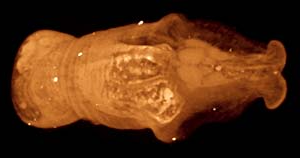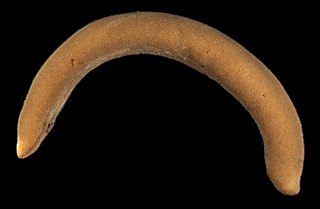
Caudofoveata is a small class within the phylum Mollusca, also known as Chaetodermomorpha. The class is often combined with Solenogastres and termed Aplacophora, but some studies have cast doubt on the monophyly of this group.

Aplacophora is a possibly paraphyletic taxon. This is a class of small, deep-water, exclusively benthic, marine molluscs found in all oceans of the world.

Proneomeniidae is a family of uncommon molluscs in the class Solenogastres.
Notomenia is a genus of solenogasters, shell-less, worm-like, marinemollusks. In this genus the animal bears non-mineralized sclerites. This genus is the sole representative of the family Notomeniidae, and has secondarily reduced its radula, which is vestigial.
The Pholidoskepia are one of the three orders of solenogaster.

The Cavibelonia are one of the four orders of solenogaster, a kind of shell-less, worm-like mollusk.
Macellomenia is a genus of solenogaster, and the only genus in its family.
Spiomenia is a genus of solenogaster, shell-less, worm-like, marine mollusks.
Plawenia a genus of solenogasters, shell-less, worm-like, marine mollusks.
Kruppomenia is a genus of solenogaster, a kind of shell-less, worm-like, marine mollusk.
Helicoradomenia is a genus of solenogasters, shell-less, worm-like mollusks.
Cyclomenia is a genus of solenogaster, a kind of shell-less, worm-like mollusk.

Rhopalomenia is a genus of solenogasters, shell-less, worm-like, marine mollusks.

Epimenia is a genus of cavibelonian solenogasters, a kind of shell-less, worm-like mollusks.
Epiherpia is a genus of solenogasters, shell-less, worm-like molluscs.
Alexandromenia is a genus of solenogaster, a kind of shell-less, worm-like mollusk.
Pruvotinidae is a diverse taxonomic family of cavibelonian solenogasters, shell-less, worm-like marine mollusks.

Rhopalomeniidae is a family of solenogaster,, a kind of shell-less, worm-like, marine mollusk.

Epimeniidae is a family of solenogaster, a shell-less worm-like mollusk.
Amphimeniidae is a family of solenogaster, a shell-less worm-like mollusk.




